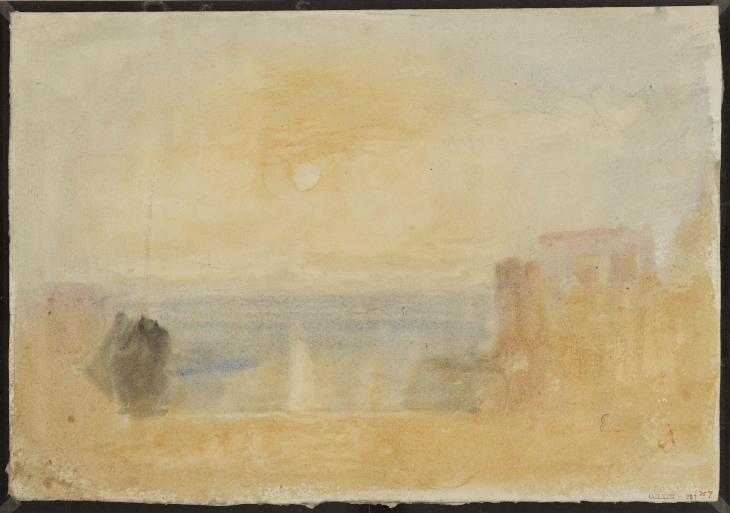Joseph Mallord William Turner ?Minehead Harbour with Dunster in the Distance c.1823-5
Joseph Mallord William Turner,
?Minehead Harbour with Dunster in the Distance
c.1823-5
Joseph Mallord William Turner 1775–1851
?Minehead Harbour with Dunster in the Distance c.1823–5
D25380
Turner Bequest CCLXIII 257
Turner Bequest CCLXIII 257
Watercolour on white wove paper, 188 x 270 mm
Partial watermark ‘tman | Mills | 23’
Blind-stamped with Turner Bequest monogram towards bottom right
Inscribed in red ink ‘257’ bottom right
Stamped in black ‘CCLXIII – 257’ bottom right
Partial watermark ‘tman | Mills | 23’
Blind-stamped with Turner Bequest monogram towards bottom right
Inscribed in red ink ‘257’ bottom right
Stamped in black ‘CCLXIII – 257’ bottom right
Accepted by the nation as part of the Turner Bequest 1856
Exhibition history
1964
Loan of Turner Watercolours from the British Museum, Graves Art Gallery, Sheffield, December 1964–January 1965, University of Nottingham Art Gallery January–March(no catalogue, as ‘Temple by the sea’).
1970
English Landscape Painting of the 18th and 19th Centuries, National Museum of Western Art, Tokyo, October–November 1970, Kyoto National Museum of Modern Art, December 1970–January 1971 (96, as ‘Temple by the Sea’, reproduced).
1978
Turner 1775–1851, Haags Gemeentemuseum, The Hague, December 1978–February 1979 (62, as ‘Temple by the sea’, reproduced).
1979
Exposicion del gran pintor ingles, William Turner: Oleos y acuarelas: Collecciones de la Tate Gallery, British Museum y otros museos ingleses, Museo de Arte Moderno, Mexico City, August–September 1979 (BM60, as ‘Templo cerca del mar’, reproduced).
1979
Oleos y acuarelas de Joseph Mallord William Turner, Museo de Bellas Artes, Caracas, Venezuela, October[–?November] 1979 (BM60, as ‘Templo a orillas del mar’).
2003
Happiness: A Survival Guide for Art + Life, Mori Arts Centre, Tokyo, October 2003–January 2004 (103, as ‘Temple by the Sea’, c.1820–30, reproduced in colour).
References
1820
A.J. Finberg, A Complete Inventory of the Drawings of the Turner Bequest, London 1909, vol.II, p.834, CCLXIII 257, as ‘Temple by the sea’, c.1820–30.
1978
John Sillevis, Nini Jonker and Hripsimé Visser, Turner 1775–1851, exhibition catalogue, Haags Gemeentemuseum, The Hague 1978, p.99 no.62, as ‘Temple by the sea’, reproduced.
1979
John Gage, Exposicion del gran pintor ingles, William Turner: Oleos y acuarelas: Collecciones de la Tate Gallery, British Museum y otros museos ingleses, exhibition catalogue, Museo de Arte Moderno, Mexico City 1979, reproduced p.44, p.61 no.BM60, as ‘Templo cerca del mar’.
1979
John Gage and Ana T. de Gradowska, Oleos y acuarelas de Joseph Mallord William Turner, exhibition catalogue, Museo de Bellas Artes, Caracas, Venezuela 1979, p.[24] no.BM60, as ‘Templo a orillas del mar’.
1997
Eric Shanes, Turner’s Watercolour Explorations 1810–1842, exhibition catalogue, Tate Gallery, London 1997, p.98 Appendix I ‘Ideal (Italianate) Landscapes’.
This glowing, golden ‘colour beginning’ of buildings and boats framing the blue sea of a bay brilliantly lit by a low sun was dubbed ‘Temple by the sea’ by Finberg,1 presumably thinking of Turner’s classical seaport paintings in the manner of Claude Lorrain (1604/5–1682), whom he greatly admired and often emulated;2 compare for example The Decline of the Carthaginian Empire, exhibited in 1817 (Tate N00499).3 The work was duly classified among ‘Ideal (Italianate) Landscapes’ by Eric Shanes,4 but the subject is somewhat closer to home, being based on a pencil drawing in the 1811 Devonshire Coast, No.1 sketchbook (Tate D08732; Turner Bequest CXXIII 202). The present author has catalogued that page as probably showing the small harbour at Minehead, Somerset, with the pier on the left and the quay on the right, looking south-east across Blue Anchor Bay with the Conygar Tower on its hill at Dunster silhouetted at the centre; compare the hill, pale in the haze, immediately to the left of the sun here. The building on the right, barely developed here, also has its equivalent in the drawing, a three-storey structure recorded in a loose manner which, combined with its uneven roofline, suggests a ruined shell.
The more developed colour study of Barnstable Bridge included in this section (Tate D25443; Turner Bequest CCLXIII 320) is in a similar Claude-like mode, with its central sun; it has been linked to the Southern Coast print scheme (see the Introduction to this section) which was the prime motivation for Turner’s 1811 West Country tour, and it is possible that the present work was also an idea for another Southern Coast composition. A watercolour of about 1818 (Lady Lever Art Gallery, Port Sunlight)5 was engraved for the series in 1821 as Minehead and Dunster Castle, Somersetshire (Tate impressions: T04404, T05453–T05454, T05987). It shows the view from the other end of the bay, with Minehead in the far distance, based on another Devonshire Coast, No.1 sketch (Tate D08672; Turner Bequest CXXIII 162a), and is worked in similarly bright but harmonious hues.
The present sheet is dated here between its watermark (evidently ‘J Whatman | Turkey Mills | 1823’ in full) and the last likely year of work on Southern Coast watercolours. The verso, Tate D41468 (Turner Bequest CCLXIII 257v), is a ‘lay-in’ of yellow sky and blue sea.
Matthew Imms
July 2016
How to cite
Matthew Imms, ‘?Minehead Harbour with Dunster in the Distance c.1823–5 by Joseph Mallord William Turner’, catalogue entry, July 2016, in David Blayney Brown (ed.), J.M.W. Turner: Sketchbooks, Drawings and Watercolours, Tate Research Publication, February 2017, https://www

